Orthodoxy in America, Part One: From the Russian Mission to the OCA
Archbishop Tikhon

In 1898, Bishop Tikhon (Belavin) (1866–1925) became the head of the Mission Diocese of the Aleutian Islands and Alaska of the Russian Orthodox Church. In 1900, the name of this diocese was changed to the Diocese of the Aleutian Islands and North America. In 1905, the Holy Synod of the Russian Church elevated the diocese to the rank of archdiocese, with Bishop Tikhon becoming an Archbishop.
In 1904, the headquarters of the American archdiocese were moved from San Francisco to New York City, to the newly built Saint Nicholas Cathedral in upper Manhattan. In 1905, Saint Tikhon’s Monastery and orphanage were founded at South Canaan, Pennsylvania, through the enterprising vision and hard work of Father Arseny (Chagovtsov) (1866–1945), the monk-priest of the parish in nearby Mayfield, Pennsylvania, who later became Archbishop Arseny of Winnipeg.

The First All-American Sobor (Council) of the Church in America took place in 1907, in Mayfield, Pennsylvania. Under Saint Tikhon’s initiative and guidance, each parish sent not only their priest, but also a lay delegate to this sobor. The theme of the sobor was “How to Spread the Mission.”
Saint Tikhon’s Overarching Plan
When all the bishops of the Russian Church were asked their opinions in 1905 regarding Church reform, Archbishop Tikhon stated that the American archdiocese should become a basically self-governing Orthodox Church made up of all Orthodox Christians of all nationalities, using the American civil calendar (i.e., the Gregorian Calendar), and eventually using the English language for its church services and activities. English translations of the main liturgical services of the Church had already been done by then, and in 1906 the landmark service book compiled and translated by Isabel Florence Hapgood was published. Archbishop Tikhon and Bishop Raphael were strongly supported in their advocacy of the use of English by Fr Ingram Nathaniel Irvine (1849–1921), a former Episcopalian priest who converted to Orthodoxy in 1905 and was ordained an Orthodox priest in that same year. Saint Tikhon assigned him to “English work” in the American Mission.
Saint Tikhon’s plan for the gradual development of an autonomous American Church included a hierarchy drawn from all the different ethnic Orthodox peoples. In 1904, Fr Raphael Hawaweeny (1860–1915), the Syrian archimandrite who had been shepherding the Arabic-speaking parishes in America since 1895 under the oversight of the Russian Diocesan Administration, was consecrated as Bishop of Brooklyn, auxiliary bishop to Archbishop Tikhon. His consecration in New York City was the first Orthodox episcopal consecration in the New World. In 2000, at a ceremony at Saint Tikhon’s Monastery, Bishop Raphael was glorified as a saint, with the designation “Bishop of Brooklyn, Shepherd of the Lost Sheep of North America.”
A similar plan was set for the consecration of a bishop from among the Serbian clergy in America, who would be responsible for the pastoral care of the Serbian Orthodox Christians scattered across North America. With this goal in mind, in 1905, Father Sebastian Dabovich (1863–1940), after being made an archimandrite, was appointed as “Administrator of the Serbian branch of the Orthodox Church in America,” with his headquarters at the Holy Resurrection Church in Chicago.
In an effort to extend this overarching plan to include the Greeks in America, in 1912 Fr Michael Andreades, a priest of Greek extraction and Dean of the West Coast parishes of the Russian Mission Archdiocese, traveled to Constantinople to request the Ecumenical Patriarch to send a Greek bishop to America, who would serve as head of the Greek-American parishes, all to be gathered within the Mission Archdiocese. Unfortunately, nothing came of this overture.
In further efforts to extend Archbishop Tikhon’s original plan, in 1916 the former Byzantine-rite Catholic priest Father Alexander Dzubay (1857–1933) was consecrated as Bishop Stephen of Pittsburgh, with special responsibility for bringing the Carpatho-Russians who were still Byzantine-rite Catholics (Uniates) into the Orthodox Church. Unfortunately, this mission was unsuccessful, and in disappointment Bishop Stephen returned to his Uniate roots in 1924.
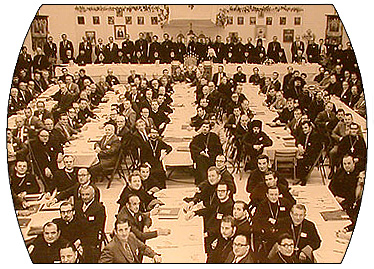
In 1919, at the Second All-American Sobor, held in Cleveland, Ohio, Archimandrite Theophan (Fan) Noli (1882–1965) was elected to be bishop of the Albanian parishes in America, and Archimandrite Mardary Uskokovich (1889–1935) was elected to be bishop of the Serbian parishes. However, with the Church in Russia in turmoil in the midst of the Bolshevik Revolution and the ensuing civil war, official ecclesiastical approval for these two consecrations never came.
This sobor also discussed positively the possibility of forming a ‘mission’ for Ukrainian immigrants, similar to that of the Serbs and the Albanians. Unfortunately, the Archbishop at that time, Archbishop Alexander (Nemolovsky), did not encourage further development of this idea.
Thus it was the plan to develop a unified hierarchy that would serve the pastoral needs of all the various ethnic immigrant groups in North America. Already in 1905, however, a “Hellenic Eastern Orthodox Church” was incorporated in the state of New York completely independent of the Russian Orthodox hierarchy in America. This was done even though at the time there was no Greek bishop in the country and no plans for a specifically Greek-American diocese—although there were already 29 Greek parishes in America by 1906.
1907–1917
After Archbishop Tikhon was transferred to a diocese in Russia in the Spring of 1907, the American diocese was headed by Archbishop Platon (Rozhdestvensky) (1866–1934; r. 1907–1914 and 1922–1934). One of the highlights of his tenure was moving the ecclesiastical seminary, called St Platon’s, from Minneapolis to Tenafly, New Jersey (across the river from Manhattan), in 1912, so that it could be much closer to the central administration of the archdiocese. He served as Archbishop of the American Church until 1914, when he was recalled to Russia to serve as a bishop there. He was succeeded by Archbishop Evdokim (1869–1935; r. 1914–1917).
From Saint Tikhon’s last sermon preached in America,
at Saint Nicholas Cathedral, New York City,
on the first Sunday of Great Lent, 1907
But it is not enough, brethren, to only celebrate “The Triumph of Orthodoxy.” It is necessary for us personally to promote and contribute to this triumph. And for this we must reverently preserve the Orthodox Faith, standing firm in it in spite of the fact that we live in a non-Orthodox country, and not pleading as an excuse for our apostasy that “it is not the old land here but America, a free country, and therefore it is impossible to follow everything that the Church requires.” As if the word of Christ is only suitable for the old land and not for the entire world! As if the Church of Christ is not “catholic”! As if the Orthodox Faith did not “establish the universe”!
Furthermore, while faithfully preserving the Orthodox Faith, everyone must also take care to spread it among the non-Orthodox. Christ the Savior said that having lit the candle, men do not put it under a bushel but on a candlestick so that it gives light to all (Mt 5.15). The light of the Orthodox Faith has not been lit to shine only for a small circle of people. No, the Orthodox Church is catholic; she remembers the commandment of her Founder, “Go ye into all the world and preach the Gospel to every creature and teach all nations” (Mk 16.15; Mt 28.19).
We must share our spiritual richness, truth, light, and joy with others who do not have these blessings. And this duty does not only lay upon the pastors and the missionaries but on the lay persons as well, since the Church of Christ, according to the wise comparison of the Holy Apostle Paul, is the body, and every member takes part in the life of the body. By means of all sorts of mutually binding bonds which are formed and strengthened through the action of every member according to his capacity, the great Church body receives an increase unto the edifying of itself (Eph 4.16).
In the first centuries it was not only the pastors who were tortured, but lay persons as well—men, women, and even children. And it was lay people likewise who enlightened the heathen and fought heresies. And now in the same way, the spreading of the Faith should be a matter that is personal, heartfelt, and dear to each one of us. Every member of the Church must take an active part in it—some by personal podvig spreading the Good News, some by material donations and service to “the needs of the holy persons,” and some by profuse prayer to the Lord that He “keep His Church firm and multiply it”—and concerning those unaware of Christ, that He would “proclaim the word of truth to them, open to them the Gospel of Truth, and join them to the Holy Catholic and Apostolic Church.” I have told this numerous times to my flock. And today, upon my departing from this land, I once more command all of you to preserve and act upon this, and especially you brethren of this holy temple. . . .
Farewell to you, this country! For some you are the motherland, the place of birth; for others you gave shelter, work, and well-being. Some received the freedom to profess the right Faith in your liberal land. . . .
Let God’s blessing be upon this country, this city, and this temple. And let “the blessing of the Lord, with grace and love for man,” rest upon you all, “now and ever and unto the ages of ages. Amen.”
Father Leonid Turkevich (1876–1965), the future Metropolitan Leonty, rector of the Seminary in Minneapolis and then in Tenafly, became the Dean of Saint Nicholas Cathedral in New York City. He wrote many articles during this period about the destiny of the American missionary archdiocese to become a self-governing Orthodox Church. Along with Archbishop Evdokim and Father Alexander Kukulevsky (1873–1963), he represented the American diocese at the great Russian Church Council of 1917–1918.
The Russian-American Archdiocese
after the Bolshevik Revolution

With the Bolshevik Revolution of 1917 in Russia, the Russian Mission Archdiocese in America was thrown into confusion. Archbishop Alexander (Nemolovsky) (r. 1917–1922), who succeeded Archbishop Evdokim in 1917, was having great difficulty in helping the Archdiocese to adjust to the new conditions, especially the loss of all financial support from the Russian Church and State. When Archbishop Platon returned to America in 1921, Archbishop Alexander asked him to take over as head of the Russian Administration. At the Third All-American Sobor of the American archdiocese, held in Pittsburgh in 1922, Archbishop Platon was accepted to lead the Church once again.
John Kedrovsky, a priest serving in the Russian-American Mission who was suspended in 1918 for attempting to subvert Archbishop Alexander’s authority, returned to America from Russia in 1923 as a “bishop” of the Soviet-mandated and manipulated “Living Church.” He demanded, and received by legal action, possession of a number of Russian Church properties, including the leading church of the archdiocese, Saint Nicholas Cathedral in New York City. His actions brought further confusion, turmoil, and financial woes to the archdiocese.
The Church suffered another major blow at this time when it was considered necessary to close the seminary in Tenafly, New Jersey, in 1924; its properties and library were sold. There would be no Orthodox seminary in North America for the next 14 years.

In 1924, the Fourth All-American Sobor of the Russian-American Archdiocese was held in Detroit, Michigan. This sobor, on the basis of Patriarch Tikhon’s decree of November 20, 1920 (No. 362)—which declared that all dioceses of the Russian Church cut off from the Moscow Patriarchate should govern themselves and carry on their church life under local supervision—declared that the archdiocese would be a self-governing metropolitanate, maintaining only a spiritual bond with the Church in Russia, until such time as normal relations could be resumed with the Russian Church. Archbishop Platon was officially installed as the metropolitan, and the Church came to be called the American Metropolia. It was legally incorporated as the Russian Orthodox Greek Catholic Church of America.
The American Metropolia
In 1926, Metropolitan Platon met with members of the Russian Synod in Exile to discuss the problems involved with caring for the Russian Orthodox Christians in the “diaspora”—meaning everywhere in the world beyond the boundaries of the Soviet Union. By this time, many new Russian immigrants had come to America and joined the American Metropolia. When the Synod in Exile attempted to extend its jurisdiction over the American Metropolia, Metropolitan Platon objected. Thus, he and his Church were “suspended” by the Synod in Exile in 1929.
At this same time, Metropolitan Evlogy (Georgievsky) (d. 1946), head of a number of parishes in Western Europe established by Russian immigrants, also met with the bishops of the Synod in Exile. He likewise was “suspended” by them for refusing to recognize their alleged jurisdiction over all Russian Orthodox Christians outside of Russia.
Pressure from Moscow
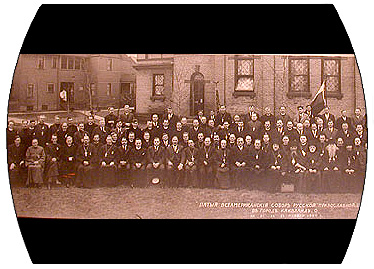
In the 1930s, pressure was applied by Moscow upon the American Metropolia, as well as upon the Western European Exarchate under Metropolitan Evlogy. In 1933, Archbishop Benjamin (Fedchenkoff) (1880–1961) came to America from the USSR demanding the Metropolia’s allegiance to the Moscow Patriarchate. The fact that a pledge of allegiance to the Soviet State was also demanded showed that the Russian Church was not really free, which made it impossible for the American Metropolia to enter into normal relations with it. In response, in 1934 the Church in Russia officially declared the Metropolia to be illegal, and opened the Exarchate of the Moscow Patriarchate in America, headed by Archbishop Benjamin. Most of the Russian-American parishes remained faithful to the Metropolia, rather than joining either this new exarchate of the Moscow Patriarchate or the Russian Synod in Exile.
In the same year, Metropolitan Platon died. He was succeeded by Archbishop Theophilus (Pashkovsky) (r. 1934–1950), who was elected primate at the Fifth All-American Sobor of the Metropolia, held in Cleveland, Ohio.
American Destiny

In 1937, the Sixth All-American Sobor of the American Metropolia, meeting in New York City, affirmed a “moral” relationship with the Russian Synod in Exile, which restored intercommunion between the two bodies. However, when the Metropolia tried to have closer relations with the Patriarchate of Moscow during World War II, the Synod in Exile disapproved. In 1946, when the Synod renewed its claim to have governance over all the Russian Orthodox in America, this “moral” relationship, including intercommunion, was broken.
The Sixth All-American Sobor also mandated the establishment of two theological schools—Saint Vladimir’s in New York City as a graduate school of Orthodox theology, and Saint Tikhon’s as a pastoral school at Saint Tikhon’s Monastery in South Canaan, Pennsylvania. Both schools opened in 1938.

The Seventh All-American Sobor of the Metropolia, meeting in Cleveland in 1946, requested of the Moscow Patriarchate that there be a close spiritual relationship linking the two bodies. But when, once again, demands were made from Moscow for loyalty to the Soviet government, the “spiritual” relationship was not realized.
In 1950, upon the death of Metropolitan Theophilus, the Eighth All-American Sobor of the Metropolia, meeting in New York City, unanimously proclaimed as primate Archbishop Leonty (Turkevich) (1876–1965; r. 1950–1965), one of the original leaders of the American missionary diocese. He had been the dean of the seminary in Minneapolis, and then in Tenafly, New Jersey. After the death of his wife in 1933, he served as bishop of Chicago.

Also in 1950, the Russian Synod in Exile set up its worldwide headquarters in New York City. Meanwhile, the Moscow Patriarchate was applying its strongest pressure for the reestablishment of its authority over the Metropolia, which it continued to call “illegal.” In response, at this Eighth Sobor, before his election as metropolitan, Archbishop Leonty made a speech reaffirming the specifically American destiny of the Church which had been planted in the New World by the Church of Russia more than a century and a half earlier. The Archbishop declared, “We will follow our line—the foundation of an administratively self-governing Orthodox Church in America.”
Development of the Metropolia
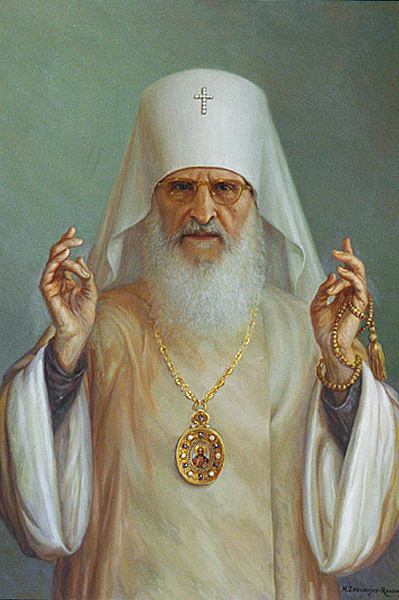
The 1950s and ’60s were difficult years in the American Metropolia. Internal disputes arose concerning the theological and spiritual development of the Church; for example, many began to desire a more adequate church life. There was an eagerness for administrative and liturgical reform that generally took the form of struggles between the clergy and the laity over their respective rights and privileges. By the end of the ’60s, however, a consensus was developing among the majority of priests and people for the implementation of proper liturgical worship, administrative order, and spiritual development in the Metropolia.
The theological schools by this time were firmly established. Saint Tikhon’s Seminary had developed considerably, while Saint Vladimir’s received a number of famous European professors—Nicholas Arseniev (d. 1977), Alexander Bogolepov (d. 1980), George Fedotov (1886–1951), Father Georges Florovsky (1893–1979), Serge Verhovskoy (1907–1986), Father Alexander Schmemann (1921–1983), and Father John Meyendorff (1926–1992). In 1967, Saint Vladimir’s received from the State of New York the right to grant the Bachelor of Divinity degree (now the Master of Divinity).
In 1960, the Romanian Episcopate, led by Bishop Valerian (Trifa) (1914–1987; r. 1958–1982), formally affiliated with the American Metropolia.
Metropolitan Ireney

Metropolitan Leonty died in May of 1965. At the Twelfth All-American Sobor of the American Metropolia, held later that year, Archbishop Ireney (Bekish) (r. 1965–1977), the acting administrator of the Metropolia, was made the new Metropolitan.
Immediately upon his elevation, Metropolitan Ireney addressed a letter to the primates of all the autocephalous Orthodox Churches, pleading for an urgent discussion about the confused jurisdictional situation of Orthodoxy in America. His appeal went unanswered. His requests made to various Orthodox patriarchs for an audience to discuss the Church in America were also refused.
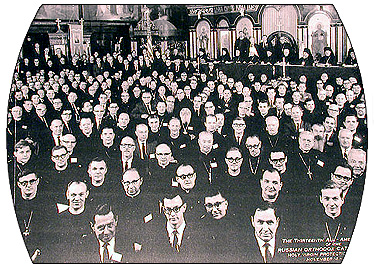
Metropolitan Ireney presided at the Thirteenth All-American Sobor of the American Metropolia in 1967, where the feeling ran high for action to declare the Metropolia to be the self-governing Orthodox Church in America without recourse to or even recognition by any patriarchate across the seas. Although no official action was taken, a “straw vote” of the council showed the overwhelming majority of delegates ready to drop the word “Russian” from the name of the Church in America, and to carry on officially as a Church in and for America.
American Autocephaly
In the late 1960s, informal talks began between representatives of the Moscow Patriarchate and the American Metropolia, usually at ecumenical gatherings, about the American problem. Official negotiations to settle the difficulties between the two Churches began in 1969. The official delegates of the American Metropolia—Archbishop Kiprian of Philadelphia, and Fathers Joseph Pishtey, John Skvir, Alexander Schmemann, and John Meyendorff—insisted upon a totally self-governing status for the Metropolia, with the complete removal of all ecclesiastical authority of the Russian Church from American territory.

After long and difficult negotiations, with many hesitations and compromises, and many meetings and discussions within both Churches over this complex and sensitive issue, on March 31, 1970, Metropolitan Ireney and Metropolitan Nikodim, head of the External Affairs Department of the Moscow Patriarchate, signed the agreement whereby the Russian Church would recognize the American Metropolia as the fully autocephalous (independent) “Orthodox Church in America” (OCA). Some 40 of its parishes, however, wished to stay under Moscow’s control, so they were allowed to join the Patriarchal Diocese established by Archbishop Benjamin in 1934.
On April 10, 1970, six days before his death, Patriarch Alexei I, together with 14 bishops of the Holy Synod of the Russian Church, signed the official tomos proclaiming the Metropolia to be the autocephalous Orthodox Church in America (OCA).
From the Tomos of Autocephaly for the OCA
The Holy Russian Orthodox Church, striving for the good of the Church, has directed her efforts toward the normalization of relations among the various ecclesiastical jurisdictions in America, particularly by negotiating with the Russian Orthodox Greek Catholic Church in America, concerning the possibility of granting autocephaly to this Church in the hope that this might serve the good of the Orthodox Church in America and the glory of God.
In her striving for the peace of Christ, which has universal significance for the life of man; desiring to build a peaceful and creative church life, and to suppress scandalous ecclesiastical divisions; hoping that this act would be beneficial to the Holy Orthodox Catholic Church of Christ and would make possible the development among the local parts of the One, Holy, Catholic and Apostolic Church of such relations which would be founded on the firm ties of the one Orthodox Faith and the love that the Lord Jesus Christ willed; keeping in mind that this act would serve the welfare of universal, mutual cooperation; taking into consideration the petition of the Bishops’ Council of the Russian Orthodox Greek Catholic Metropolitanate of North America, which expressed the opinion and desire of all her faithful children; acknowledging as good for Orthodoxy in America the independent and self-sustaining existence of said Metropolitanate, which now represents a mature ecclesiastical organism possessing all that is necessary for successful further growth. Our Humility together with the Sacred Synod and all the venerable Hierarchs of the Russian Orthodox Church, who have signified their agreement in writing, having examined the said petition, in sincere love grant autocephaly to the Russian Orthodox Greek Catholic Church in America, that is, the right of a fully independent ordering of church life in accordance with the divine and sacred Canons and the ecclesiastical practices and customs of the One, Holy, Catholic and Apostolic Church inherited from the Fathers; for which purpose this Patriarchal and Synodal Tomos is directed to His Beatitude, IRENEY, Archbishop of New York, Primate of the Autocephalous Orthodox Church in America, Metropolitan of All-America and Canada. . . .
Confirming the Autocephaly of the Russian Orthodox Greek Catholic Church in America, we bless her to call herself The Holy Autocephalous Orthodox Church in America; we acknowledge and proclaim her our Sister Church, and we invite all local Orthodox Churches and their Primates and their faithful children to acknowledge her as such and to include her in the dyptichs in accordance with the Canons of the Church, the traditions of the Fathers and ecclesiastical practice.
The newly-established local Orthodox Autocephalous Church in America should abide in brotherly relations with all the Orthodox Churches and their Primates as well as with their bishops, clergy and pious flock, who are in America and who for the time being preserve their de facto existing canonical and jurisdictional dependence on their national Churches and their Primates.
With profound, sincere joy, We announce this to the Fullness of the Church and We do not cease thanking the All-Gracious Almighty God, who directs all in the world by His right hand for the good and the salvation of mankind, for the successful and final formation of Autocephaly, and we entreat the all-powerful blessing of God upon the younger Sister in the family of local Autocephalous Orthodox Churches, the Autocephalous Orthodox Church in America.
May the Consubstantial and Life-creating and Undivided Trinity, Father, Son and Holy Spirit, acting on Its own wondrous providence, send down on the Archpastors, Pastors and Faithful Children of the Holy Autocephalous Orthodox American Church Its heavenly, unfailing help, and may It bless with success all her future endeavors for the good of the Holy Church.
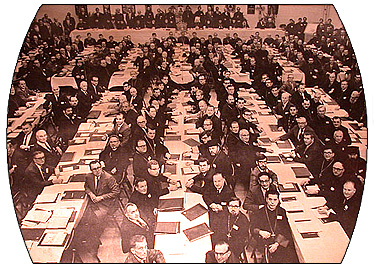
At the Fourteenth All-American Sobor of the American Metropolia, held at Saint Tikhon’s Monastery in South Canaan, Pennsylvania, on October 20–22, 1970, the tomos of autocephaly—which had been formally received on behalf of the American Church by a delegation of churchmen led by Bishop Theodosius (Lazor) of Sitka, Alaska—was officially read and the event was solemnly celebrated. The new status of the Church was accepted and affirmed by the members of the council by a vote of 301 to 7, with 2 abstentions. This council thus became the First All-American Council of the autocephalous Orthodox Church in America.
In 1971, the Second All-American Council of the new Church, also held at Saint Tikhon’s, adopted the official governing statute of the Church. It also accepted the Albanian diocese that had been led by Bishop Theophan (Noli), and was now headed by Bishop Stephen (Lasko), into the Orthodox Church in America.
Canonization of Saint Herman
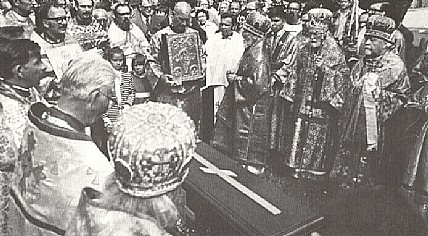
On August 9, 1970, the OCA celebrated the canonization of its first saint, Father Herman of Alaska. A member of the first group of missionary monks to come to Alaska in 1794 from the Valaam Monastery, Saint Herman, a simple lay monk, remained among the Alaskan people as their protector, teacher, and intercessor before God until his death in 1836. The canonization ceremonies, attended by Archbishop Paaveli of the Finnish Orthodox Church, took place in Kodiak, Alaska.
Two years later, under the heavenly patronage of Saint Herman, the Saint Herman’s Pastoral School was established in Anchorage to train native Alaskan clergy. In the next year it was moved to Kodiak.
Aftermath of the Autocephaly
The act of recognition by the Moscow Patriarchate of its former missionary diocese in the New World as an autocephalous Orthodox Church, as of 2013, had still not been officially accepted by all of the Orthodox Churches worldwide. Only the Churches of Russia, Bulgaria, Poland, Georgia, the Czech Lands, Slovakia, and Finland had issued official statements of recognition.
From the beginning, the Patriarchate of Constantinople, its American Greek Orthodox Archdiocese, and the other Greek-speaking Churches worldwide strongly opposed and condemned the act of autocephaly. Nevertheless, all Orthodox Churches, including the Patriarchate of Constantinople and the other Greek-speaking Churches, remained in full sacramental and spiritual communion with the Orthodox Church in America.
Continuing Development of the OCA
In 1972, the Orthodox Church in America opened its Mexican Exarchate, headed by Bishop José Cortes y Olmos (1923–1983). Raised in the Roman Catholic Church, he joined the Mexican National Catholic Church in 1951. This group, independent from the Roman Church, was proclaimed the Mexican National Catholic Church in 1928 by the president of the country in the aftermath of the Mexican Revolution that began in 1910; its creation, colored by political overtones, was indicative of a broader movement of independence from subjection to the Church of Rome. Bishop José became the head of that church in 1961. Then, after considerable study of Orthodoxy, he and his entire church appealed to the newly formed OCA to accept them. After Bishop José’s death in 1983, he was not replaced until Archimandrite Alejo (Pacheco-Vera) was consecrated as Bishop of Mexico by Metropolitan Herman and other bishops of the OCA in 2005.
In 1976, most of the Bulgarian Orthodox in America—about 15 parishes—were received into the OCA with their Archbishop Kirill (Yonchev) (1920–2007), who was made the OCA Bishop of Pittsburgh and Western Pennsylvania. He led the diocese until his death in 2007. He was succeeded by Bishop Melchizedek (Pleska) (b. 1942).
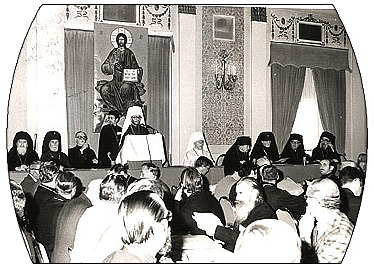
At the Fifth All-American Council, held in Montreal, Canada, in October 1977, Metropolitan Ireney, due to reasons of health, resigned as Primate of the Orthodox Church in America. As no candidate for the office of Metropolitan received the necessary two-thirds vote for election on the first ballot, the assembly nominated two American-born bishops as candidates: Bishop Dmitri (Royster) (1923–2011) of the Diocese of Hartford and New England, and Bishop Theodosius (Lazor) (b. 1933) of the Diocese of Pittsburgh and West Virginia. Bishop Theodosius was subsequently elected by the Synod of Bishops to succeed Metropolitan Ireney as ruling hierarch, thus becoming the first American-born bishop to hold the office of Primate of the Orthodox Church in America.
Some of the highlights during Metropolitan Theodosius’s tenure were the canonization of Saint Innocent, Apostle to America, by the Church of Russia in 1977; the authorization in 1988 by the State of Pennsylvania for Saint Tikhon’s Seminary to grant the Master of Divinity (M.Div.) degree; the canonization of Saint Alexis of Wilkes-Barre in 1994 at Saint Tikhon’s Monastery; and the canonization of Saint Raphael of Brooklyn in 2000, also held aaint Saint Tikhon’s Monastery.
In 2002, Metropolitan Theodosius retired for health reasons. At the Thirteenth All-American Council, held in Orlando, Florida, in that year, Archbishop Herman (Swaiko) (b. 1932) was elected to be the new metropolitan. He served until 2008, when he was forced to retire due to a financial scandal. He was succeeded by Bishop Jonah (Paffhausen) (b. 1959), who only 11 days after becoming Bishop of the South was elected to be the new metropolitan at the Fifteenth All-American Council, held in Pittsburgh in November of 2008. Metropolitan Jonah was the first convert to lead the OCA.
In November of 2011 the Sixteenth All-American Council was held in Bellevue, Washington, a suburb of Seattle. The theme for the council was “The Household of Faith.” This was the first All-American Council or Sobor to be held west of the Mississippi River. This allowed for the largest delegation from Alaska ever to attend one of these councils and sobors.

On July 6, 2012, Metropolitan Jonah retired in the midst of controversy. He was followed by the new Metropolitan Tikhon (Mollard) (b. 1966), who had been Archbishop of the Diocese of Philadelphia and Eastern Pennsylvania. Metropolitan Tikhon was elected to be the new metropolitan at the specially called one-day Seventeenth All-American Council, held in Parma, Ohio, on November 13, 2012.
